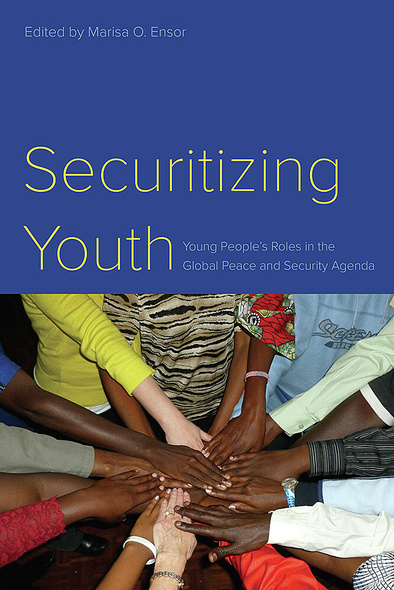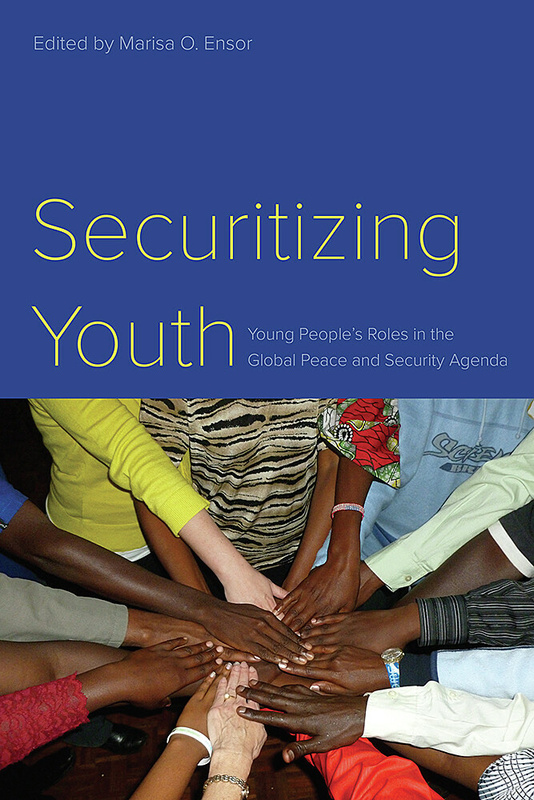Securitizing Youth
Young People's Roles in the Global Peace and Security Agenda
Edited by Marisa O. Ensor
Rutgers University Press
Securitizing Youth offers new insights on young people’s engagement in a wide range of contexts related to the peace and security field. It presents empirical findings on the challenges and opportunities faced by young women and men in their efforts to build more peaceful, inclusive, and environmentally secure societies. The chapters included in this edited volume examine the diversity and complexity of young people’s engagement for peace and security in different countries across the globe and in different types and phases of conflict and violence, including both conflict-affected and relatively peaceful societies. Chapter contributors, young peacebuilders, and seasoned scholars and practitioners alike propose ways to support youth’s agency and facilitate their meaningful participation in decision-making. The chapters are organized around five broad thematic issues that correspond to the 5 Pillars of Action identified by UN Security Council Resolution 2250. Lessons learned are intended to inform the global youth, peace, and security agenda so that it better responds to on-the-ground realities, hence promoting more sustainable and inclusive approaches to long-lasting peace.
Anyone interested in understanding youth as a demographic dividend will find this book fascinating. Securitizing Youth provides an excellent overview of key issues raised by the UN’s policy focus on youth that is detailed, informative and accessible. The chapters provide keen insights into important topics ranging from youth engagement in mediating local conflicts to addressing climate change and their role in transitional justice. Marisa Ensor has made a significant contribution to this field of study.
Today’s super-youthful world features a dispiriting irony: young people at the center of much policy discussion usually are unable to make their own case. Fortunately, the contributors in this important book collectively contrast current policy confusions with dynamic youth on the ground. The result is a timely, foundational book. Strongly recommended.
Anyone interested in understanding youth as a demographic dividend will find this book fascinating. Securitizing Youth provides an excellent overview of key issues raised by the UN’s policy focus on youth that is detailed, informative and accessible. The chapters provide keen insights into important topics ranging from youth engagement in mediating local conflicts to addressing climate change and their role in transitional justice. Marisa Ensor has made a significant contribution to this field of study.
Today’s super-youthful world features a dispiriting irony: young people at the center of much policy discussion usually are unable to make their own case. Fortunately, the contributors in this important book collectively contrast current policy confusions with dynamic youth on the ground. The result is a timely, foundational book. Strongly recommended.
MARISA O. ENSOR is a gender and youth specialist with a background in the human dimensions of disasters, environmental change, conflict, displacement and security. She is currently based at Georgetown University’s Justice and Peace Studies Program.
Introduction
Marisa O. Ensor
PART I Participation
1 Peace by, for, or with Youth? How a PYD Lens Enhances Our View of Young People’s Role in Peacebuilding
Carole MacNeil
2 And Then They Came for Me: Youth’s Role in Mediating for Peace in Kibera, Kenya
Grace Atuhaire
PART II Protection
3 Protecting Marginalized Youths: Romani Children and Formal Education
Diana Budur
4 Squeezed Agency: Youth Resistance to the Securitization of Peacebuilding
Ali Altiok
PART III Prevention
5 Lost in Translation? Youth Employment and Peacebuilding—from Policy to Programs
Valeria Izzi
6 Community Ties, Training, and Technology: A More Effective Framework for Peace, Security, and Development for Afghan Youth
Nasrat Khalid
PART IV Partnerships
7 Climate Change, Environmental Action, and the Youth, Peace, and Security Agenda: Global Policies, Local Efforts
Marisa O. Ensor
8 Putting Youth on the Agenda: Intersections with the Women, Peace, and Security Framework
Jeni Klugman and Matthew Moore
PART V Disengagement and Reintegration
9 Securitized Youth, Transitional Justice, and the Politics of Disengagement in Rwanda
Victoria R. Bishop
10 Digital Media as the Next Frontier for Fighting Violent Extremism among Youth?
Willice Onyango
Conclusions: Securitizing Youth—Lessons Learned
Marisa O. Ensor
List of Contributors
Index
Marisa O. Ensor
PART I Participation
1 Peace by, for, or with Youth? How a PYD Lens Enhances Our View of Young People’s Role in Peacebuilding
Carole MacNeil
2 And Then They Came for Me: Youth’s Role in Mediating for Peace in Kibera, Kenya
Grace Atuhaire
PART II Protection
3 Protecting Marginalized Youths: Romani Children and Formal Education
Diana Budur
4 Squeezed Agency: Youth Resistance to the Securitization of Peacebuilding
Ali Altiok
PART III Prevention
5 Lost in Translation? Youth Employment and Peacebuilding—from Policy to Programs
Valeria Izzi
6 Community Ties, Training, and Technology: A More Effective Framework for Peace, Security, and Development for Afghan Youth
Nasrat Khalid
PART IV Partnerships
7 Climate Change, Environmental Action, and the Youth, Peace, and Security Agenda: Global Policies, Local Efforts
Marisa O. Ensor
8 Putting Youth on the Agenda: Intersections with the Women, Peace, and Security Framework
Jeni Klugman and Matthew Moore
PART V Disengagement and Reintegration
9 Securitized Youth, Transitional Justice, and the Politics of Disengagement in Rwanda
Victoria R. Bishop
10 Digital Media as the Next Frontier for Fighting Violent Extremism among Youth?
Willice Onyango
Conclusions: Securitizing Youth—Lessons Learned
Marisa O. Ensor
List of Contributors
Index






